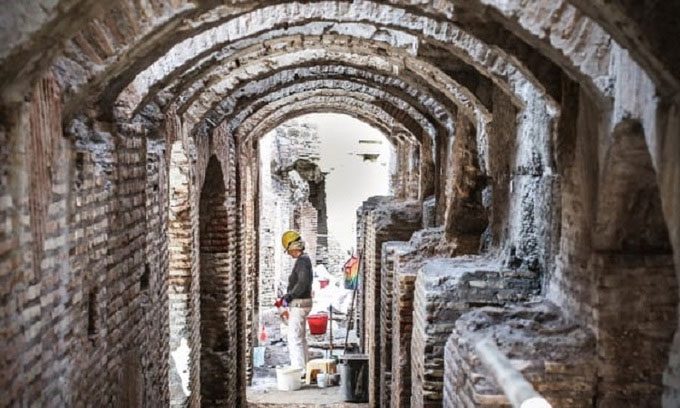For the first time in 2,000 years, the underground chamber where gladiators and animals awaited their turn to enter the arena at the Roman Colosseum is now open to visitors after a long restoration.
Currently, visitors can walk along the wooden pathways, admiring the corridors and arches that connect to the underground waiting area for gladiators and animals before taking the elevator up to the arena. In ancient Rome, these rooms were lit by candles. However, after the ground floor of the amphitheater was destroyed, those on the upper levels could clearly see the waiting area thanks to sunlight streaming in.

The waiting area beneath the Roman Colosseum during restoration. (Photo: Tod).
The Italian Ministry of Culture announced the restoration project for the waiting area and pathways of the amphitheater. Alfonsina Russo, director of the Archaeological Park of the Colosseum, stated that the project will help the public better understand how the structure once operated.
The decade-long restoration project was initiated by Diego Della Valle, the CEO of the fashion company Tod’s, in collaboration with the Archaeological Heritage Agency of Rome in 2011. Tod’s contributed $30 million to the restoration costs. The project is being carried out in three phases, starting with a thorough cleaning of the amphitheater’s facade, followed by work on the underground areas. The restoration of the underground waiting area began in 2018.
The restoration project of the Roman Colosseum brings together numerous archaeologists, restoration specialists, engineers, and architects. They utilize photo surveys, ground mapping, dust cleaning, sediment removal, and the organization of microorganisms such as algae and lichens. In certain areas, the restoration team had to relocate remnants of previous repairs that had decayed over time and replace them with more reliable materials. Experts also installed systems to reduce water seepage in the foundation stones, one of the main causes of decay.
The Roman Colosseum was built by Emperor Vespasian in 72 AD and completed eight years later. Vespasian’s son, Titus, inaugurated the amphitheater with 100 days of games, including mock battles, confrontations with wild beasts, and gladiatorial contests. According to the ancient historian Eutropius, 5,000 animals were killed during these events.
At its height, the Colosseum could hold 50,000 to 70,000 spectators. After the fall of the Roman Empire, the structure was used for housing and as a source of materials for other buildings around the city.





















































